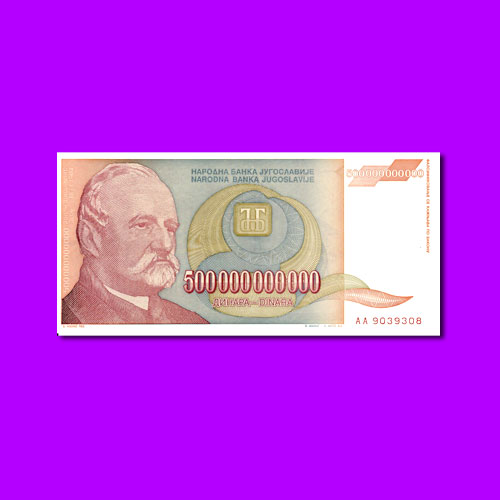Top 5 Most Unusual Banknotes
2020-04-23 Thu
Most banknotes we use every day don’t seem unusual or in any way diverse than what you'd normally expect from a banknote: a face of someone historically significant and a national symbol or a monument. Nonetheless, there are some that go way beyond the common. Here are some of the most unusual banknotes ever issued and their story behind it.1. 500 Billion Yugoslavia Banknote: This former European country called Yugoslavia experienced super hyperinflation in 1989 which continued until economic reforms took place in 1994. The highest banknote denomination in 1988 was 50,000 Dinara, but this had changed to 500,000,000,000 Dinara by 1994.
2. One Hundred Trillion Dollars of Zimbabwe: Worth about US$300, the Reserve Bank of Zimbabwe began printing these $100 trillion banknotes in January 2009. In July 2008, the country had the highest inflation rate in the world at 231 million percent. A single loaf of bread cost roughly 300 billion Zimbabwean dollars.
3. 100 Million Billion Pengo of Hungary: Before WWII, the Pengo suffered the highest rate of hyperinflation ever recorded and issued the 100 Million Billion Pengo in 1946. It was worth only about 20 US cents. The Hungarian Bank actually printed notes of one milliard b.-pengo (one sextillion pengo) but never issued them.
4. World’s Oldest Banknote 1380 China: The earliest recorded use of paper money is in China around 800 AD, although the Chinese abandoned paper money in the mid-fifteenth century. The Chinese Kuan note is the world's oldest known banknote, dating from around 1380.
5. World’s Largest Banknote from the Philippines: As large as a sheet of legal paper, the world's largest single banknote is the 100,000-peso note created by the Government of the Philippines in 1998 to celebrate a century of independence from Spanish rule. The note was offered only to collectors, who could purchase one of the limited-edition notes for 180,000 pesos (around 2.6 lakh rupees).
Latest News
-
Mahatma
2024-04-25 ThuIndia Post issued a commemorative postage stamp on #LalaHansraj, also known as Mahatma Hansraj for�...
-
Berar Mint of Muhammad Akbar
2024-04-25 ThuBerar was a kingdom located in the Deccan region, with Elichpur as its capital. It was one of the Su...
-
Janma Kalnayak of Bhagwan Mahavir
2024-04-24 WedOn 21st April 2024 which was the 2550th Janma Kalnyanak of Bhagwan Mahavir Swami, PM Modi unveile...
-
Gold Pagoda of Vijaynagar Empire King Deva Raya I
2024-04-10 WedKing Deva Raya I of the Vijayanagara Empire was a patron of Kannada literature and architecture. He ...
-
Silver Denarius of Septimus Severus
2024-04-05 FriLucius Septimius Severus served as the Roman emperor from 193 to 211 AD. Severus sat on the throne o...

